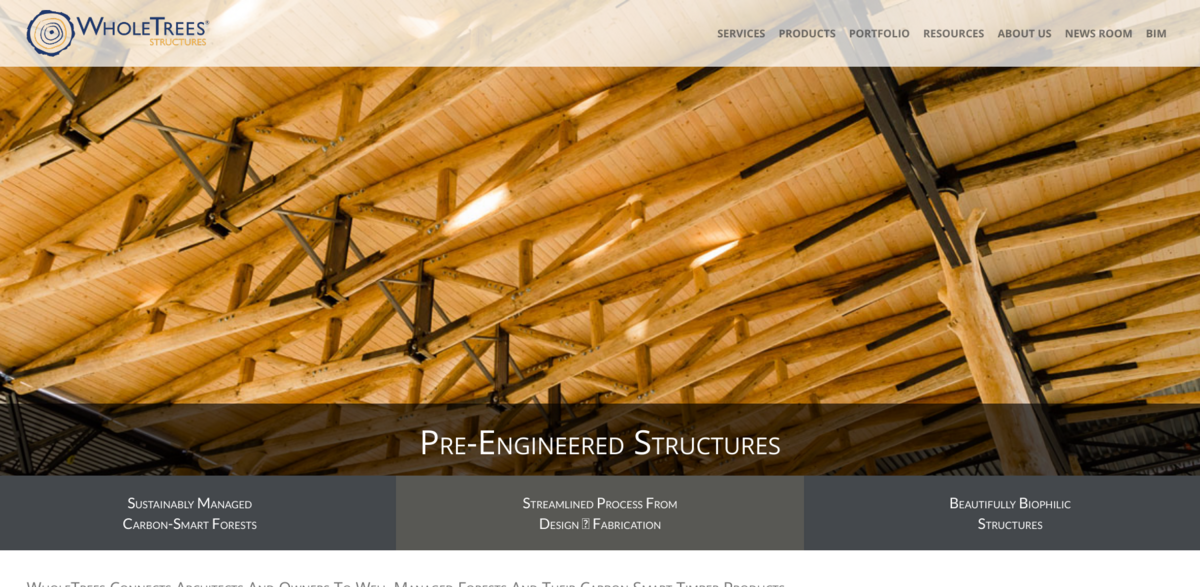What WholeTrees Is All About
WholeTrees connects architects and owners to well-managed forests and their carbon-smart timber products. Founded in 2007, WholeTrees taps into the inherent strength of Structural Round Timber (SRT) and millions of years of organic structural engineering to deliver beautiful, sustainable, affordable, and durable biophilic structural systems that actually restore forests. Headquartered in Madison, WI, with teams spread coast to coast, the company acts as the go-to hub linking well-managed forests, biophilic architectural designs, cutting-edge 3D scanning and inventory management tools, and solid structural timber (SST) products. It’s a unique blend of nature, technology, and design all rolled into one.
Main Benefits of WholeTrees’ Approach
Here’s what makes WholeTrees stand out:
- Founded in 2007 with over a decade of expertise
- Uses Structural Round Timber (SRT) for strength and beauty
- Offers sustainable, affordable, and durable biophilic structural systems
- Headquartered in Madison, WI, with nationwide teams
- Bridges forests, architecture, 3D scanning, and timber products
- Partners with USDA Forest Products Laboratory to develop grading systems and software
- Utilizes advanced scanning technology to create BIM 3D models for design
- Works with carbon-smart forests emphasizing longer rotation ages and environmental care
Guiding Clients Through the Specification Process
WholeTrees doesn’t just supply timber—they guide clients through the entire specification process. Drawing on decades of experience, they transform what the conventional lumber industry might see as excess byproduct into strength and beauty. Their expert assistance helps bring trees right into your design vision, making the natural world a core part of architectural creativity. It’s not just about wood; it’s about crafting stories and structures that resonate with nature’s own design principles.
Innovative Use of Technology in Timber Design
One of the coolest things WholeTrees does is use scanning technology to capture the unique shape of real trees. This data is then turned into BIM 3D models that designers can incorporate into CAD drawings. This means architects and builders get to work with the organic shapes of trees, not just generic timber pieces. It’s a perfect marriage of nature’s complexity and modern design tools, enabling structures that are both functional and visually stunning.
Partnerships with Carbon-Smart Forests
WholeTrees has built strong relationships with carbon-smart forests across the country. These partnerships reflect shared values like longer rotation ages and a deep attention to the environment’s future. By working closely with foresters and landowners, WholeTrees ensures that the timber inventory is cataloged on their Timbers Digital Platform, which also serves as inspiration for designers. This approach supports a vision where forests and communities thrive together, creating prosperity that’s sustainable and meaningful.
Project Impact on Sustainable Development Goals (SDGs)
- SDG 11: Sustainable Cities and Communities – promoting biophilic design and sustainable building materials
- SDG 12: Responsible Consumption and Production – utilizing byproducts and reducing waste in the lumber industry
- SDG 13: Climate Action – supporting carbon-smart forestry and reducing carbon footprints
- SDG 15: Life on Land – encouraging sustainable forest management and biodiversity
- SDG 8: Decent Work and Economic Growth – fostering rural economies through sustainable forest product markets
The Importance of Working Forests
A working forest is more than just trees—it’s a carefully managed ecosystem providing a sustainable supply of wood products, paper, biomass, wildlife habitat, recreation, hunting, clean air and water, and countless other societal benefits. These forests support regional, local, and rural economies by relying on strong markets for wood products. Diverse markets reduce the risk of forests being converted to other land uses and encourage landowners to invest in treatments that keep forests healthy and productive. WholeTrees’ work helps maintain this balance, ensuring forests remain vibrant and valuable for generations to come.





















